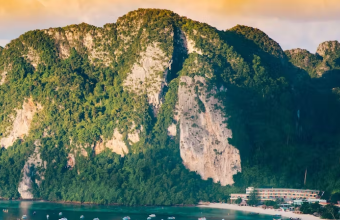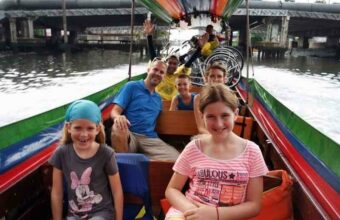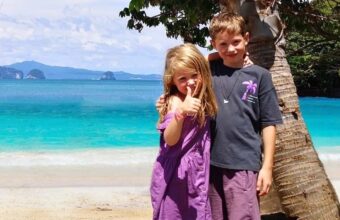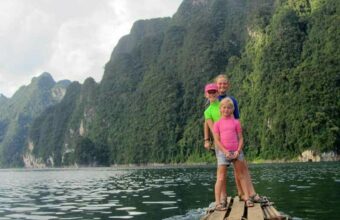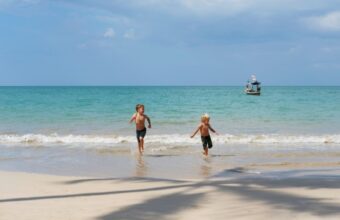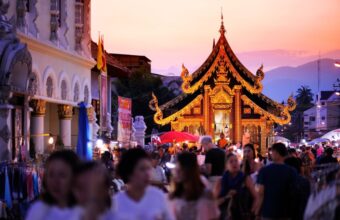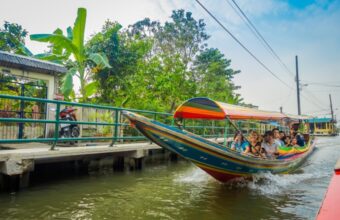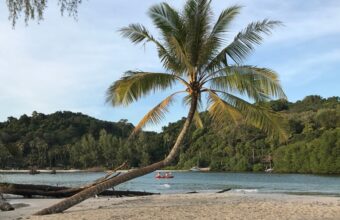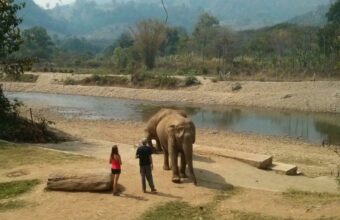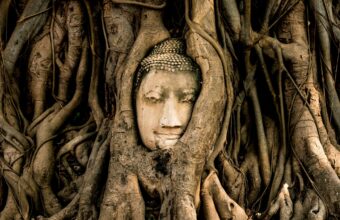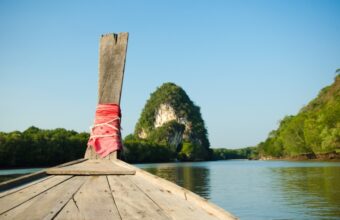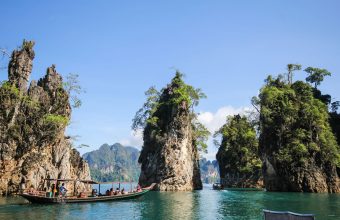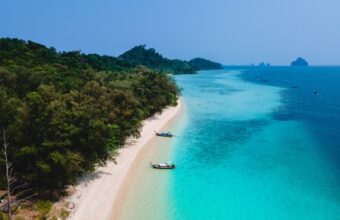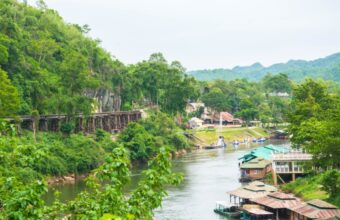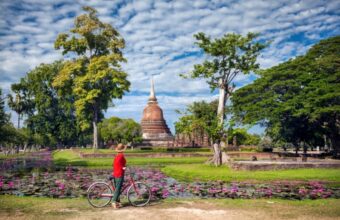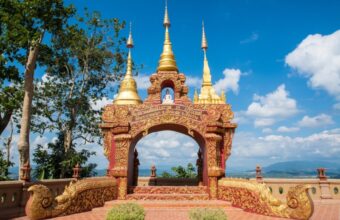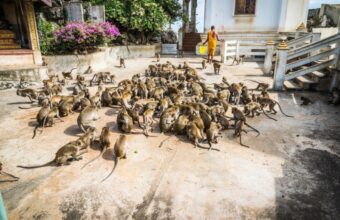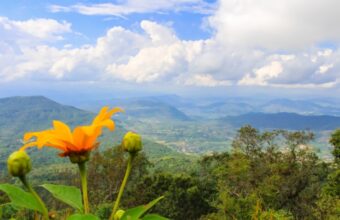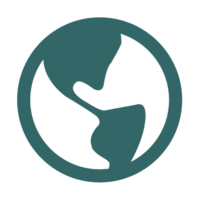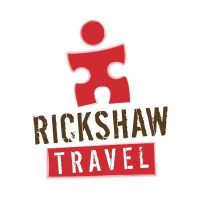Thailand with kids
Everything you need to know about visiting Thailand with the family
If you're visiting Thailand with kids I'm sure the obvious contenders will already be on your radar: the temples of Bangkok, a cooking class in Chiang Mai, maybe an elephant sanctuary, one of the islands, and call it a wrap.
There's nothing wrong with any of that, but take my advice: I've been living in and writing about Thailand since 2011 and I can tell you there is so much more to the country that doesn't make the standard "top 10" lists and travel brochures. If you're even vaguely interested in getting the kids off the beaten path and seeing some of the "real" Thailand, this guide is for you.
And now is a great time to bring the family to Thailand. The country has been working hard to shed its reputation as a backpacker party hub, and reinvent itself as a family-friendly travel destination. It's a wonderful place to visit for all ages and with great transport, escaping the crowds can be easy and fun – even with kids in tow.
But with beautiful beaches to buzzing cities; from nature reserves to culture and sport; from relaxing by a pool to experiencing a jungle adventure... just where do you start? You start right here: with my expert guide to visiting Thailand with kids. Happy travels!
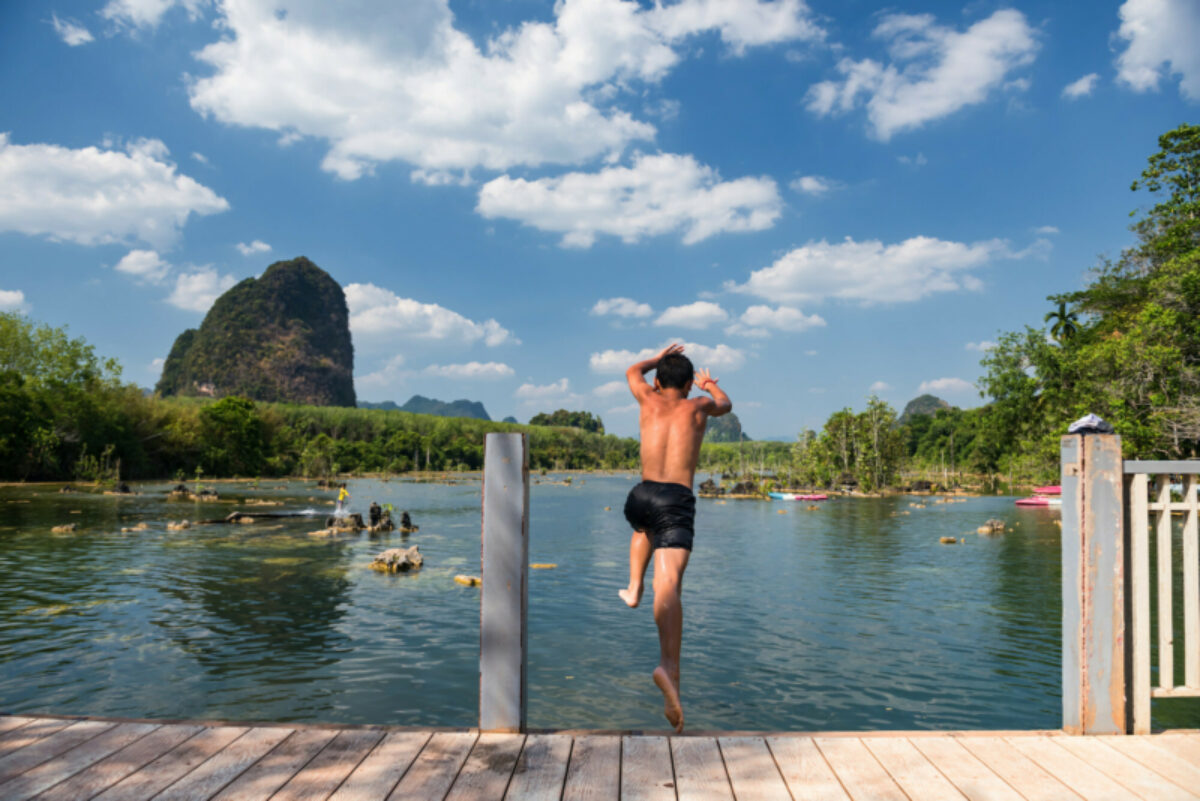
Classic kid-friendly fun in Krabi
What to do in Thailand with kids
Popular – and some lesser-known – places to visit in Thailand with the family
-
Khao Lak
-
Chiang Mai
View trips -
Bangkok
View trips -
Ko Mak
-
Chiang Mai
View trips -
Ayutthaya
View trips -
Krabi
View trips -
Khao Sok
View trips -
Trang
-
Kanchanaburi
View trips -
Sukhothai
-
Chiang Rai
View trips -
Prachuap Khiri Khan
-
Chiang Khan
Visiting Thailand with kids: Need to know
Everything you need to plan a happy trip
Thai people adore kids, often doting over foreign children like celebrities. Visitors to Thailand with kids usually encounter the best of the famed Thai charm.
And the country also offers terrific value, quality accommodation for all budgets, a huge selection of destinations and activities, and the travel and tourism infrastructure is well established – all of which means the country is beautiful, welcoming and safe.
Here are my top tips on planning a safe and happy trip to Thailand with the kids.
Getting around Thailand with kids is easier than you think
You can hire a car but using public transport and hiring local drivers or tour companies for excursions works well in much of Thailand. Bus, train and ferry tickets can almost always be booked as you go, unless you plan to get really off the beaten track or you’re intending to use the sleeper trains from Bangkok to Chiang Mai, or Surat Thani. Don't expect sleeper berths if you don’t book ahead.
You can buy bus and train tickets online, but it's often easier to get tickets at transport stations or from small travel agencies at street level, many of which can be found online as well. Widely available at popular tourist destinations, these old-style travel outlets can arrange a transfer from your hotel to the bus or ferry to ease your journey. They can also help to arrange tours, private drivers, and more.
Most families book lodgings and internal flights in advance. Booking rooms weeks before you leave home could mean lower rates, availability of the best lodgings, and more time to enjoy your trip. Do compare room rates at a given property's official website (if available) with hotel-booking websites.
If your trip coincides with holiday periods - Christmas week, Lunar New Year and Songkran (Thai New Year), for example - be sure to book rooms well in advance or you might find slim pickings, especially on the islands.
One note of warning for families: Taxis often don’t have child-safety seats.
Getting around the cities with kids
Metro
Bangkok's metro can be confusing. It consists of three systems - BTS, MRT and SRT, and between them they reach most of the key areas and attractions, and both airports. If you’re switching from one system to another - and sometimes if you’re switching to a different line within the same system - you have to pay a separate fare. All three are safe, clean and reliable, but getting a pram or bulky luggage on board can be a challenge during rush hours. The staff do their best to help, but some stations are not wheelchair accessible.
Ferries
Ferries cross Bangkok’s Chao Phraya River, and also cover longer distances. The cramped local ferries stop at dozens of piers marked by orange flags, while ferries geared towards tourists only stop near major attractions, and cost three times more. Another ferry runs on the San Saeb Canal, linking the historic district to the main shopping area, and beyond. All the ferries can be fun to use, but getting on and off the local ferries can be hectic at busy times.
Taxis
Taxis are cheap and easy to catch anywhere in Bangkok. Grab is the most popular ride-hailing app.
Regular taxis have meters that drivers are required by law to use, but some will try to negotiate a fixed price at the start of the journey. Others may not turn the meter on and then surprise the unsuspecting passenger with an exorbitant bill. Before getting in, politely ask the driver to use the meter. If they refuse, simply flag down the next one.
Tuk tuks
Tuk tuks (three-wheeled motorised trikes with seating for three adults behind the driver) are common. The noisy machines are best avoided during rush hours in Bangkok, when you risk breathing in traffic fumes. And be warned, they do not have seatbelts.
Tuk tuks do not have meters so you need to negotiate the fare with the driver, which often means the ride will be pricier than the taxi equivalent.
Songthaew
The most common form of public transport in provincial Thailand is the songthaew, a small pick-up truck with a roof over two benches in the back of the truck. They usually have pre-determined routes but in some areas they can also be booked as taxis. They tend to be cheap, but drivers in touristy areas will charge a premium. Again, be warned, they don’t have seatbelts.
Walking
If you want to walk, Bangkok can be a challenge even without kids. Smaller cities are more pedestrian-friendly and some towns are conducive to bicycles, available from travel agents and, sometimes, from lodgings. Motorbike rental is more widely available, but do read the safety concerns below.
Getting between the cities with kids
Car rental
With an international driving licence you can hire a car at the airports as well as at local offices, either on the spot or by booking ahead. Many travel agencies offer cars and vans with drivers, be it for a single journey or an entire trip. You can also arrange a taxi or songthaew for private day trips but you’ll need to negotiate the price with the driver.
Not surprisingly, hiring a car will be more expensive than public transport, but it may make sense if you have a large family. It may also be the only way to get a child-safety seat.
For longer journeys, Thailand has well-developed networks of inter-provincial bus, train, sea and air services. Dabbling in each is a good way to go.
Flights
Most domestic flights are cheaper in Thailand than in the West, and Bangkok links with 34 commercial airports. Phuket and Ko Samui are the only islands with airports, but some airlines offer all-in tickets covering the flight, a van to the pier and a ferry to your island. Airlines providing domestic services in Thailand include THAI, Thai Smile, Bangkok Airways, Nok Air, Thai AirAsia, Thai Lion Air and Thai VietJet. You won’t find some of them on booking sites. Note that Bangkok has two major airports, Suvarnabhumi (BKK) and Don Mueang (DMK). If you have to change planes in Bangkok, be sure to book flights that use the same airport, or factor in an extra two hours to take a shuttle bus from one to the other.
Rail
The State Railway of Thailand (SRT) operates trains on four main lines: Northern, Western, Southern and North-eastern. Railways do not run to most of the eastern seaboard or the southwest coast. New trains are now in service on popular routes, but most are old and slow. They can be fun though, and private cabins are available along with sleeper bunks and three classes of seats. For short trips, second-class fares with cushioned seats, open windows and fans are usually suitable for families.
Intercity bus
The sprawling public bus system - a mix of many private companies and the government’s reliable Transport Company (with a 999 logo) - reaches from Bangkok to every provincial capital. Passenger vans, or rot tuu, are increasingly replacing the full-size rot tour buses for regional routes. These vans are often cramped and dangerously driven, with no child safety seats, so do check if a regular bus is available instead. Many of the full-size buses have bathrooms.
Boats & ferries
Boats to the islands range from multi-deck vehicle ferries to large speedboats, and slow wooden vessels access small islands near the mainland. Island-hopping ferries connect islands within certain regions and archipelagos, but only during the dry season in the Ko Chang archipelago (eastern Gulf of Thailand), and the lower Andaman Sea south of Ko Lanta.
Longtail boats
These traditional fishing boats are great fun for private island-hopping over short distances, especially in the southwest where these banana-shaped vessels are most common. You'll also find sailboat, speedboat and yacht charters available online and through travel agencies at popular islands and beaches.
Staying safe and healthy in Thailand with kids
Travel can be slow and tiring. Trains run late, taxis get stuck in traffic, language barriers, though usually surmountable with patience, can cause confusion and frustration. Some travel agents, taxi drivers and seemingly friendly strangers do try to overcharge or scam foreigners.
Be on your guard, but it's also important to maintain jai yen - a cool heart. Thai society values composure. Staying calm and patient in difficult situations nearly always helps to solve problems. Getting angry and confrontational invariably makes things worse.
Most of Thailand is suitable for families with children, but keep the following safety issues in mind.
On the road
Thailand has one of the world’s highest rates of road traffic deaths. Unlicensed driving, drink-driving, riding motorbikes on the wrong side of the road, and other reckless road uses, are all common.
Planes and trains are safer than full-size buses (especially at night), which in turn are safer than public vans. Motorbikes are the most dangerous. Every year tourists riding with little understanding of Thai traffic laws and unwritten road rules end up in hospital, or worse, with hefty medical bills not covered by travel insurance.
An international or Thai motorcycle licence is essential if you're going to ride even a low-powered scooter, and check that your insurance policy gives you the right cover. Motorbike rental outlets do not usually offer insurance. Typically, the renter is responsible for damage to the bike and for injuries they cause others. Helmets are essential, and beware that large islands like Phuket, Ko Samui, and Ko Chang are particularly dangerous.
Thailand is a left-driving country like the UK and Australia, but driving similarities end there. Aggressiveness is the norm. Courtesies common in the West, like stopping to let pedestrians cross the road, can be dangerous in Thailand because they're likely to cause confusion. Also, when a driver flashes their headlights in Thailand, it means “stay out of my way!”.
If you’re walking, assume that pedestrians never have the right of way over a vehicle, even at zebra crossings (crosswalks). Beware of crossing a road even if a walk signal is flashing, and use pedestrian bridges if possible. Keep small children close to you.
Crime and violence
Muggings are rare in Thailand, but watch out for bag snatchers and pickpockets. Sexual violence and harassment of women is a longstanding problem, but the threat is reduced significantly for women travelling with a family. Violent crime occurs mostly late at night, often at bars, and typically involving personal conflicts.
Thailand's political situation has long been plagued by instability and repeated military coups. Turbulent political demonstrations hit Bangkok periodically with some violence and public disorder, though foreigners have never been targeted. However, try to avoid any demonstrations you come across.
Violence related to a long-running insurgency in Thailand's deep southeast rarely spills out of the provinces of Pattani, Narathiwat, Yala, and the southernmost districts of Songkhla. That apart, the south is no less safe than other regions.
Sea and animal threats
Look for red flags indicating unsafe swimming conditions on beaches throughout Thailand. Each rainy season, riptides and rough seas cause drownings. Don't hesitate to cancel or postpone a boat trip if the sea is rough or storms are forecast. Some boat captains will risk the safety of tourists (and themselves) rather than lose a day’s income due to bad weather. If possible, use large slow boats or longtail boats, rather than speedboats, for day tours or island-hopping. Also be careful about where you snorkel - boats are not always driven safely.
Most of the stray dogs, cats and monkeys you’ll see on beaches and in cities are harmless, but occasionally one may bite. You might want to carry a packet of dried chilli pepper to toss at an animal that gets too close for comfort. Consider a rabies vaccination before you go.
Shark attacks are almost non-existent. Bull sharks have inflicted injuries once every six years, on average, over the past two decades. However, box jellyfish can be fatal, mainly during the rainy season. Thailand's many poisonous snakes avoid humans, but beware of camouflaged tree vipers when exploring around waterfalls.
Mosquitoes can be vicious, particularly during the rainy season. Malaria is only a concern if travelling in remote jungle areas, but mosquitoes do transmit the potentially deadly dengue fever in more populated areas.
Hot and cold
The heat in Thailand can be dangerous and heat stroke is common among tourists. Keep hydrated and try to avoid being out and about during the midday peak heat. Sunscreen, light clothing and hats are essential, but take something warm as well. It can get surprisingly cool in mountainous areas especially in the dry season, and indoors, air-con is often kept very cool.
Food and water safety
Thai food can be extremely spicy, but cooks often tone down the heat for foreign tourists. Burgers and pasta are easy to find, and higher-end supermarkets like Tops or Villa Market have decent selections of imported foods.
Thailand is famous for street food, and enjoying a meal curb-side can be a thrill for both the flavours and atmosphere. Consider hiring an experienced street food guide in cities like Bangkok and Chiang Mai if you're worried about food hygiene or intimidated by the lack of English-language menus. A food tour can also be a great way to interact with locals while learning about everyday culture.
Out-of-sight restaurant kitchens are not necessarily cleaner than street kitchens out in the open. Good indicators of hygiene are the containers set on tables for dried chillies and other spices. If they don't look clean or recently refilled, go elsewhere.
Check that meat is fully cooked. Food that sits out in hot weather - on trays at khao gaeng (rice and curry) shops for example - is more likely to cause food poisoning than made-to-order dishes.
Drinking only filtered water is sensible, and vending machines that pour filtered water into reusable containers are fairly common. Ice served at restaurants and street stalls is typically made with filtered water and although some travellers avoid fresh fruits and vegetables washed in tap water, this is usually unnecessary.
It’s a myth that Thailand's tap water comes straight from the canals. Most of it goes through extensive purification. A five-year study completed in 2018 found that 98.4 percent of Bangkok's tap water met safety criteria set by the World Health Organisation. However, water quality in rural areas is not always up to that standard.
Most of Thailand's best hospitals are privately run and Bangkok Hospital is one of the largest and most reliable.
Thailand with kids packing essentials
If you’re travelling with very small children bring a baby sling and perhaps a light, foldable pram for tight urban areas. City footpaths can be narrow, and even non-existent in places, uneven, and with plenty of obstacles in the way.
Minimarts such as 7-Eleven stock nappies, wet wipes, baby formula, mosquito repellent and sunscreen. Larger stores like Big C and Lotus's (formerly Tesco Lotus) offer more choice. Boots and Watsons are two of the most popular chain drug stores. Locally-owned pharmacies are also common and the staff usually speak enough English to help you.
Baby foods and formulas sold in Thailand are safe, but the instructions on the packets may be in Thai only, so you may want to bring your own. Electric kettles are common in hotel rooms and hot water is free at most minimarts.
Public restrooms are easy to find but they may not always be clean. Soap is not always provided, so carry hand sanitiser. Some toilets are flushed by pouring water from provided buckets and although Western-style toilets are common, you may still be faced with a squat toilet.
ATMs, banks and foreign currency exchange booths are easy to find in all cities and most tourist centres, but some small islands lack ATMs. Credit cards are accepted at large stores and restaurants, and increasingly, for public transport. Cash is usually needed for street food, tuk tuk rides, and other small purchases.
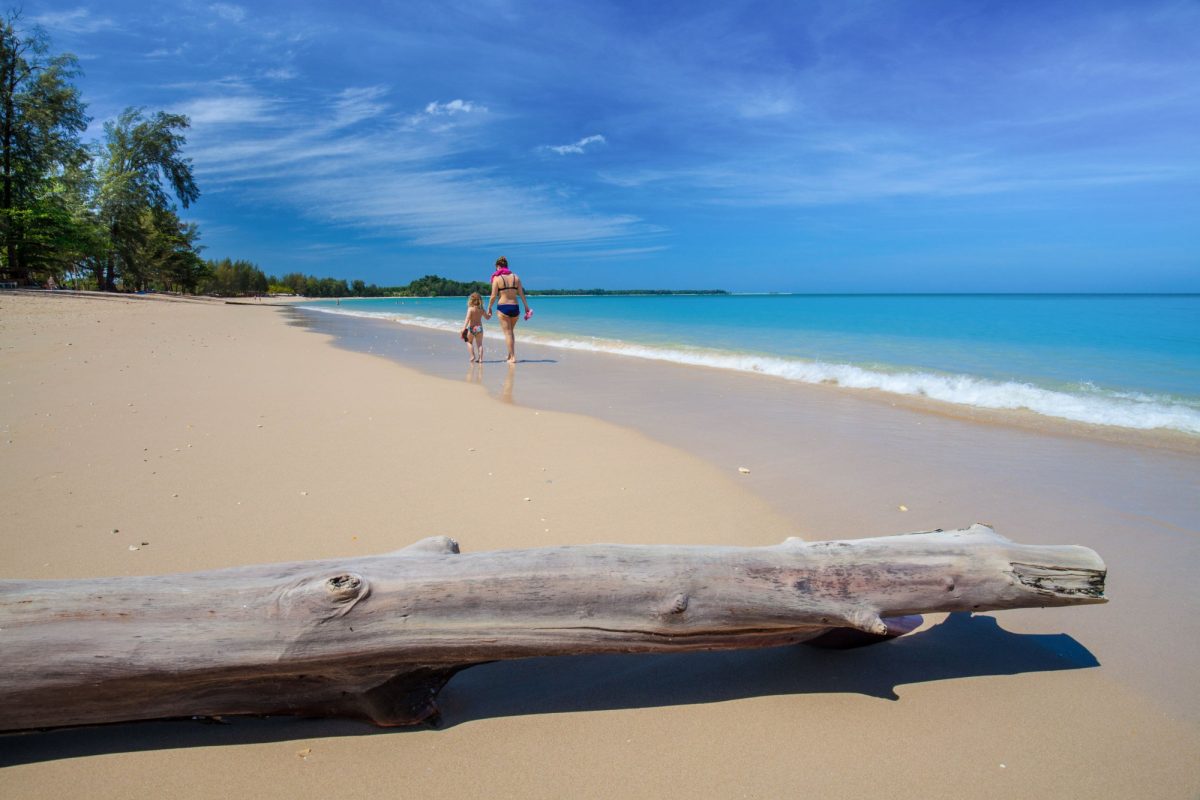
Quiet beaches on Khao Lak
Thailand with kids: FAQs
Your questions, our expert's answers
Question
We want to do day trips but we're worried about motorbiking with a toddler. Of Samui, Chang or Lanta which is best for getting around?
Answer
You can get around safely without a motorbike in all of the main islands; there are usually other family-friendly forms of transport.
Some of the islands, like Chang and Samui, have songthaews (pick-up trucks with roofed benches in the back) that connect all of the main beaches, although they are pricey compared to the mainland; expect to pay at least a few hundred baht even if going a short distance.
Lanta and other islands around there (such as Jum) have salengs (sidecar motorbike taxis) which are more affordable. You'll also find tuk tuks and regular taxis in places. Or, if you have an international drivers licence and would prefer to drive yourself, car and jeep rental is available on Samui, Lanta and Chang.
Otherwise, if you want to go out you can always ask the reception staff to call a driver for you; indeed that is often the only way to find a driver on Kood. But finding a saleng on Lanta or a songthaew on Chang is typically easy in all the main areas.
Question
Of Ko Samui, Ko Chang, or Ko Lanta, which would you recommend most for a family with a toddler?
Answer
I think all three of the areas you've singled out (Samui, Lanta, Chang) can be great for families with a toddler. Two weeks is plenty of time so wherever you are, you could easily spend a week at the main island and then take one of the easily available island hopping boats (dry season only) to check out some of the smaller islands. I always recommend some of those smaller islands because the beaches are often more beautiful than on the main island.
Of the three areas I personally prefer the Koh Chang Archipelago and Koh Lanta / Krabi / Trang areas because, although Koh Chang and Koh Lanta are both sizable tourist destinations, they are both more laid back and not as developed or mainstream as Koh Samui.
Although Koh Chang does have some slightly seedy nightlife on the main road near White Sand Beach, neither Chang or Lanta are as seedy as parts of Samui, around Chaweng and Lamai. (That said, the south of Samui is a whole different story and you could easily stay there and never even stop at Chaweng or Lamai if you wanted.)
One thing that Samui, Chang and Lanta have in common – and I would also say this about Koh Phangan – is that they're all beautiful but also big enough to have totally different "vibes" or "scenes" in different areas. So on any of them you can stay in a quieter area that still puts you within relatively easy access of all attractions and other parts of the islands.
If you want to do some island hopping, a slowboat from Koh Chang to Koh Mak to Koh Kood, or ferry from Krabi town to Koh Lanta and then private longtail boat around the Trang islands, would be, I think, more exciting than the larger ferries to Koh Samui / Koh Phangan / Koh Tao.
Question
We're visiting Thailand with four kids in March-April and are concerned about the burning season in the north. Do you have any advice?
Answer
March to April is peak burning season, and during that period Chiang Mai in the north is routinely ranked among the worst air quality on earth. Visiting Thailand with kids, I'd definitely avoid the north during that period and if you're worried about air quality, I'd probably avoid Isaan and the central region, too. Perhaps even more pressing for travelling with family, the heat can be brutal during this time.
On the other hand, the coast and islands in southern Thailand are lovely in March/April. Still hot, but with the cooling effect of the ocean to help with the kids.
If you feel like you're missing out on the north you can visit scenic mountain areas like Khao Sok and Khao Luang. And for the best family friendly beaches/islands at that time, I'd recommend Khao Lak on the Andaman coast – it's popular with families, with plentiful activities including day tours to some of Thailand's most spectacular islands, namely the Similans and Koh Surin. The Gulf side such as Koh Samui and around is also pretty in March - April.
Question
We're visiting Hua Hin with my in-laws, but are there more beautiful places to visit nearby with kids aged 3, 7 and 9?
Answer
I agree there are probably better places than Hua Hin to visit with kids, although I can see the appeal – it has good restaurants, markets and accommodation. And there are some great family-friendly day trips from Hua Hin:
One highly underrated idea is Kui Buri National Park, which is by far the best place in Thailand to spot wild elephants (as well as gaur, the world's largest bovine species). I'm 40 years old but had all the excitement of a kid when piling into the back of a pick-up truck and driving slowly down dirt tracks into the mountains, stopping often to watch the elephants in the forest and grasslands. You have close to a 100% chance of seeing wild elephants in Kui Buri National Park, whereas it's something like 10% in Khao Yai and maybe 30% in Kaeng Krachan, both of which are far better known for wildlife than Kui Buri.
Other family-friendly day trips out of Hua Hin include the Pala-U Waterfall where you also might spot wild elephants; the mangrove forest park in Pranburi where kids enjoy peeping the crabs from elevated walkways that pierce a vast mangrove forest; the Khao Tao area where Sai Noi Beach is a well-kept secret that is arguably among the best mainland beaches in all of Thailand and situated a short hike from a good viewpoint with a Buddha image; and finally the Khao Sam Roi Yot National Park which has some fabulous caves and viewpoints amid a dramatic karst mountain landscape to go with notably scenic lotus-filled wetlands on the inland side of the park.
I'd also keep Sam Roi Yot in mind as a secondary overnight destination. Just north of the park, the lengthy beach known as Hat Sam Roi Yot or Hat Phu Noi has some good family beach resorts – one called Dolphin Bay is popular thanks to its big pool with waterslides – with a much quieter and more laid-back vibe than Hua Hin.
Question
We're a big group (seven adults, two kids aged 3 and 6), can you recommend some beach areas that might suit?
Answer
I'll suggest one destination in the Gulf of Thailand and another on the Andaman coast. Which one you choose partially depends on when you're travelling. The rainy season in the Gulf starts around Aug-Sep and lasts straight through December. Rainy season on the Andaman coast is from around May-June through October, although in recent years it seems to be starting later and lasting into Nov or even Dec.
In the Gulf, Koh Samui might work for your group because it has plenty of private house / villa rentals. These cater for many budgets, from extreme luxury on the beach to rather modest options set down inland lanes. So if you're looking for a place to all stay together in one big house, with its own kitchen and perhaps its own swimming pool, consider Samui.
The areas that are quietest and generally considered best for families are Samui's northern beaches like Bophut, Mae Nam and Bang Po, as well as southern and western beaches like Taling Ngam and Lipa Noi. Chaweng and Lamai are the two busiest beaches and both have some seedy nightlife along with techno-blasting beach parties, etc., but there are rental houses along the quieter nearby inland lanes.
On Samui you have a solid list of attractions on the island, and those who want more adventure will find some of Thailand's most dazzling islands if day tripping into the nearby Ang Thong National Park. You could hire a private boat for that or book into a group tour. Another nearby island that you might find worth a day trip is Koh Matsum, where kids often enjoy seeing the domesticated boars that live on the beach.
Meanwhile on the Andaman coast, the Khao Lak area is not far from Phuket but much quieter and without the traffic jams and seedy nightlife (to be fair, several parts of Phuket, such as Bang Tao and Kamala beaches, are also good for families). Khao Lak might work for you because there's loads to do, including day tours to nearby Similan or Surin islands, both of which are also part of national parks and also rank among the most dazzling islands in Thailand. Or you could go to the sea turtle conservation centre or, if you're really lucky, even possibly see turtles hatching on nearby Khao Lampi and Thai Mueang beaches. Other kid friendly activities here are visiting the old town market in nearby Takua Pa, a boat tour of the magnificent Phang Nga Bay, miniature golf, the butterfly farm, and the night markets and many different beaches within the Khao Lak area.
Perhaps not ideal for younger kids but worthwhile for everyone else, is a visit to the deeply moving 2004 tsunami memorial just north of Khao Lak in Ban Nam Khem.
Question
Can you recommend any mountain areas for a larger family?
Answer
I think Chiang Rai would be a great choice for a large family, particularly if you're willing to splash out on tours or a private van for excursions outside the provincial capital city.
Chiang Rai is a bit further off the beaten path than Chiang Mai, but still relatively easy to reach and with plenty of local travel offices and tour operators that can assist English-speaking travellers.
The provincial capital is full of photogenic temples and museums and also has a great night market. There are loads of trips from the city, including the Tham Luang Cave that was the site of the incredible rescue of 12 boys and their football coach back in 2018. Other good options include mountain viewpoints like Doi Tung and historic Mekong River towns like Chiang Khan, or if going further up into the mountains, the tea-growing outpost of Mae Salong.
Do keep in mind that, as with virtually any mountainous area in Thailand, travelling involves winding roads with switchback turns. Also the entire north gets hit by bad air pollution late in the dry season. I do not suggest going up there in March or April and even in February the air can get bad as farmers start to burn off the stubble in their fields.
One other suggestion is Kanchanaburi, which isn't too far from Bangkok and can be fun for families especially if you're interested in the World War II history. If you go, the Hellfire Pass Memorial and Museum is not to be missed. Kanchanaburi province has some of Thailand's best waterfalls, such as Huai Mae Khamin and Erawan. While it might be too far out of the way for a large family, the lake mountain town of Sangkhlaburi is an enchanting place.

